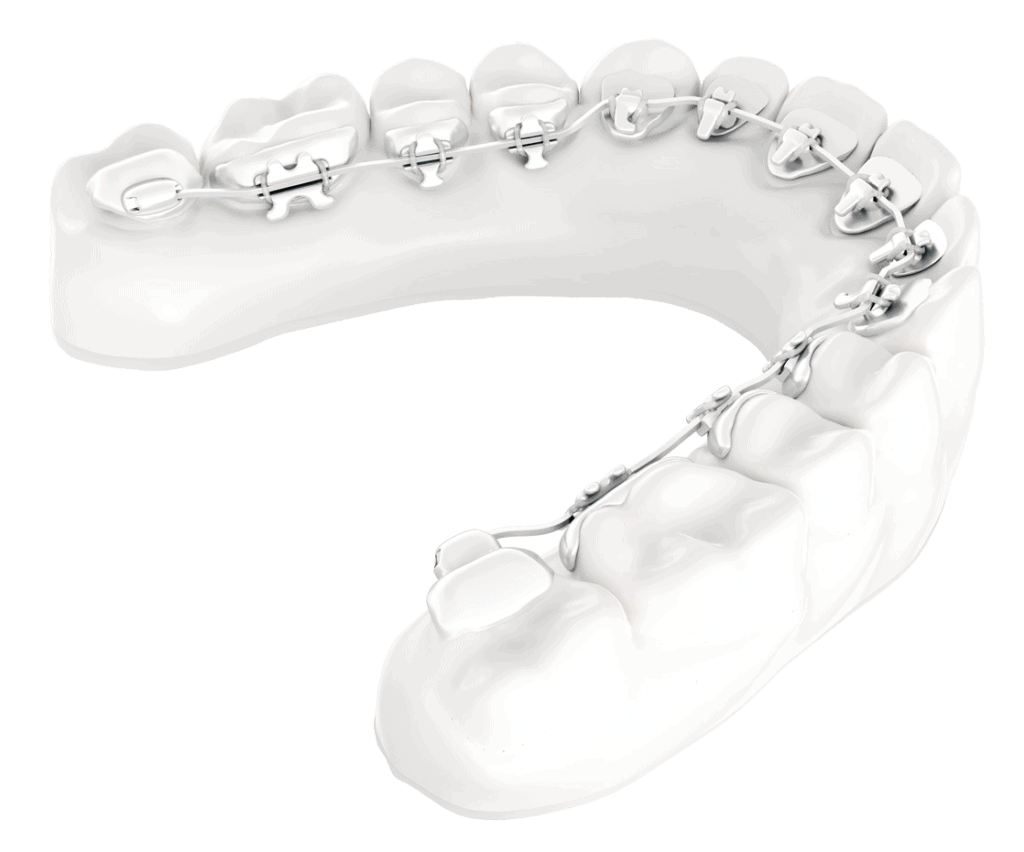Introducing Lingual Orthodontics
Lingual orthodontics is a type of Invisible treatment where custom made metal braces are bonded to the inside of your teeth making them virtually invisible. This is a very discrete and precise way for straightening teeth. This is why public figures, executives, athletes, models, actors and actresses, TV presenters and musicians tend to opt for these hidden braces.

A Sophisticated Solution
Lingual braces are just as effective as the traditional braces bonded to the front of your teeth. They work in much the same way, the main difference being they are more discrete and aesthetic. They are totally invisible braces.
At Masters Orthodontics we are certified in two of the most widely used lingual braces systems, INCOGNITO and WIN lingual braces. Both offer a completely customised treatment plan where each bracket is made to fit specifically on each individual tooth. In other words, it’s a completely bespoke brace personalised to offer you the best possible end results.
By using the latest advances in scanning and 3D technology, we can accurately model the shape of your teeth using CAD / CAM computer software thus allowing lingual braces will fit perfectly and snuggly to the back of your teeth. The wires are bent by precision robotics to match the exact shape of your teeth.
Why Choose Lingual Braces?
The main advantage of Lingual Orthodontics is aesthetics during treatment. The fixed appliance is glued to the inside of the teeth. No one will know that you are undertaking orthodontic treatment unless you decide to tell them. This is a very discreet option and the only truly invisible alternative to traditional fixed braces.
Because they are custom made, they adapt to the internal surface of your teeth perfectly. As a result of this customised adaptation, studies have shown that the risk of having tooth decay and demineralisation during orthodontic treatment decrease when compared to traditional braces.
Some patients are allergic to nickel. Incognito braces are made of gold which makes them a safe alternative for those with allergies.
As for disadvantages; lingual braces, Incognito and WIN, do tend to be more expensive than other types of braces mainly due to the costs in their manufacturing process and the longer appointments required to adjust them.

Frequently Asked Questions
Depending on the severity of the underlying problem, lingual braces range from £4000 for simpler alignment cases to £8500 for more complex cases. Each patient is different, with different needs and as such the price will differ based on the complexity of the case.
The treatment length varies from patient to patient and is based on individual needs. Depending on how severe the problem is it can take anything from 6 months to simple alignment cases to 24 months for more complicated ones. They are similar to other treatment options like fixed brace and aligners when it comes to treatment length. No one treatment can claim to be faster than the other as the teeth will move at their own rate.
Lingual braces are not painful. Initially, you might feel some discomfort until you grow accustomed to them but this tends to be temporary and short-lived. Like with any orthodontic appliance there is an adaptive period. Because they are placed on the back of your teeth, they can initially cause some irritation to your tongue but as with normal braces, you can use orthodontic wax to protect and soothe the area.
Lingual braces work in much the same way as conventional braces on the front of your teeth. The biology behind tooth movement is still the same: in essence, you apply a force to a tooth and through inflammation, the tooth will move in the direction of the force applied. The main difference is that in lingual orthodontics, the braces are hidden which offers a much more cosmetic and discreet alternative to conventional braces.
Both Lingual braces and Invisalign are a cosmetic alternative to traditional fixed braces. Invisalign isn’t as discreet as the lingual alternative as you still see the aligners but has the advantage of being removable. Lingual braces, on the other hand, are the only true real “invisible” orthodontic appliance. I think the choice between one or the other ultimately depends on the patient's personality and lifestyle. Some people like the flexibility of being able to remove the aligners whilst others prefer to have a fixed option as they are afraid they might not be disciplined enough to use them as instructed. Some people have jobs that demand a fully invisible brace alternative for example.
Biomechanically they work very differently as well: in a nutshell, one is still “braces and wires” (albeit on the back of your teeth) whilst the other is a thermoformed plastic mouthguard that pushes teeth into different pre-programmed positions. The main advantage of Invisalign over Lingual (or traditional braces for that matter) is hygiene. Because aligners are removable, you can brush your teeth much easier than with fixed alternatives. Having said that, studies have shown that when compared to traditional braces, lingual braces have a much lower risk of decay and demineralization during and after orthodontic treatment.
Lingual braces tend to be more expensive than other traditional options because the manufacturing process and the development of the braces and wires is more expensive. The appointments are usually longer as they tend to be more laborious to adjust, mainly because of the limited visibility and access to them inside the patients mouth. It is also important to understand that not all Orthodontists are qualified to fit lingual braces. Those who are need further training in this technique and as such, tend to charge more because of the specialist nature of their services.
Lingual braces are just as effective as other orthodontic modalities such as Invisalign or traditional braces. They all have the same objective: to straighten teeth! The main advantage is the fact that they are fully invisible. Certain movements, however, like rotations and space closure after extractions are more predictable with lingual braces when compared to Invisalign.
Lingual braces are usually fitted by qualified Orthodontists. Having said that, not all Orthodontists can fit lingual braces. This type of brace requires to undergo further specialist training.
Most dental problems can be fixed with lingual braces in much the same way as with traditional braces on the front of your teeth. One of the biggest challenges with lingual braces, however, are very deep bites. Increased overbites can be a challenge as the lower teeth will have a tendency of hitting the back of the upper teeth where the upper braces are bonded. Depending on the severity of the overbite, we can sometimes add some resin build-ups to create some clearance between the lower teeth and the upper brackets which prevent them becoming dislodged.